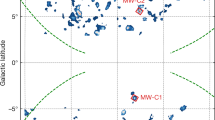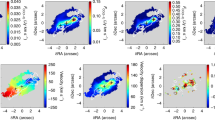Abstract
The formation of stars begins with the collapse of a dense interstellar cloud core to a protostar surrounded by a disk of gas and dust. Material in the envelope of the cloud core falls inwards to feed further growth of the protostar and its accretion disk. At some point during the accretion phase, an outflow of gas begins along the disk's rotation axis. Outflows have been studied in a large number of sources1, and recently it has become possible to study infall (and outflow) very close to the star2,3,4,5,6,7,8. But the possible interaction between these flows and its effect on the mass of the disk and the young star remain uncertain. Here we present observational evidence for an interaction between infalling and outflowing molecular gas. The opening angle of the outflow cone is largest near the star, indicating a widening of the outflow with time. Outside the lobes of the outflowing gas we see a narrow, disk-like region that is infalling. We suggest that the widening of the outflow may isolate the disk from further infall.
This is a preview of subscription content, access via your institution
Access options
Subscribe to this journal
Receive 51 print issues and online access
$199.00 per year
only $3.90 per issue
Buy this article
- Purchase on Springer Link
- Instant access to full article PDF
Prices may be subject to local taxes which are calculated during checkout



Similar content being viewed by others
References
Bontemps, S., Andre, P., Terebey, S. & Cabrit, S. Evolution of outflow activity around low-mass embedded young stellar objects. Astron. Astrophys. 311, 858–872 (1996).
Langer, W. D., Velusamy, T. & Xie, T. IRS1 circumstellar disk and the origin of the jet and CO outflow in B5. Astrophys. J. 486, L41–L44 (1996).
Chandler, C., Terebey, S., Barsony, M., Moore, T. J. T. & Gautier, T. N. Compact outflows associated with TMC-1 and TMC-1A. Astrophys. J. 471, 308–320 (1996).
Chandler, C. & Sargent, A. I. The small scale structure and kinematics of B335. Astrophys. J. 486, L29–L32 (1993).
Velusamy, T., Kuiper, T. B. H. & Langer, W. D. Imaging infall: CCS observations of protostellar envelope of B335. Astrophys. J. 451, L75–L78 (1995).
Bachiller, R., Guilloteau, S. & Dutry, A. Jet driven molecular outflow in L1448-C. CO and continuum synthesis images. Astron. Astrophys. 299, 857–868 (1995).
Gueth, F., Guilloteau, S., Dutrey, A. & Bachiller, R. Structure and kinematics of a protostar: mm-interferometry of L1157. Astron. Astrophys. 323, 943–952 (1997).
Ladd, C. J. & Fich, M. The structure and energetics of a highly collimated bipolar outflow: NGC2264G. Astrophys. J. 459, 638–652 (1996).
Goldsmith, P. F., Langer, W. D. & Wilson, R. W. Molecular outflows, gas density distribution, and the effects of star formation in the dark cloud Barnard 5. Astrophys. J. 303, L11–L15 (1986).
Bally, J., Devine, D. & Alten, V. Aparsec-scale Herbig–Haro jet in Barnard 5. Astrophys. J. 473, 921–928 (1996).
Stahler, S. The kinematics of molecular outflows. Astrophys. J. 422, 616–620 (1994).
Raga, A. c., Cantó, J., Calvert, N., Rodriguez, L. F. & Torrelles, J. M. Aunified stellar jet/molecular outflow model. Astron. Astrophys. 276, 539–5482 (1993).
Masson, C. R. & Chernin, L. M. Properties of jet-driven molecular outflows. Astrophys. J. 414, 230–241 (1993).
Li, Z.-Y. & Shu, F. H. Magnetized singular isothermal toroids. Astrophys. J. 472, 211–224 (1996).
Smith, M. D., Suttner, G. & Yorke, H. W. Numerical hydrodynamical simulations of jet-driven bipolar outflows. Astron. Astrophys. 323, 223–230 (1997).
Nagar, N. M., Vogel, S. N., Stone, J. M. & Ostriker, E. C. Kinematics of the molecular sheath of the HH111 optical jet. Astrophys. J. 482, L195–L198 (1997).
Parker, N. D., Padman, R. & Scott, P. F. Outflows in dark clouds: their role in protostellar evolution. Mon. Not. R. Astron. Soc. 252, 442–461 (1991).
Hayashi, M., Ohashi, N. & Miyama, S. Adynamically accreting gas disk around HL Tauri. Astrophys. J. 418, L71–L74 (1993).
Burrows, C. J. et al. Hubble Space Telescope observations of the disk and jet of HH30. Astrophys. J. 473, 437–451 (1996).
Beckwith, S. & Sargent, A. I. Circumstellar disks and the search for neighbouring planetary systems. Nature 383, 139–144 (1996).
Chernin, L. M. & Masson, C. R. Momentum distribution in molecular outflows. Astrophys. J. 455, 182–189 (1995).
Shu, F., Najita, J., Galli, D., Ostriker, E. & Lizano, S. in Protostars and Planets III (eds Levy, E. H. & Lunine, J. I.) 3–45 (Univ. Arizona Press, Tucson, 1993).
Beichman, C. A. et al. Formation of solar type stars: IRAS observations of the dark cloud Barnard 5. Astrophys. J. 278, L45–L48 (1984).
Acknowledgements
We thank Caltech's OVRO staff for their assistance and support. The Owens Valley Radio Observatory millimeter-wave array is supported by the NSF. This research was conducted at the Jet Propulsion Laboratory, California Institute of Technology, under contract with NASA.
Author information
Authors and Affiliations
Corresponding author
Rights and permissions
About this article
Cite this article
Velusamy, T., Langer, W. Outflow–infall interactions as a mechanism for terminating accretion in protostars. Nature 392, 685–687 (1998). https://doi.org/10.1038/33624
Received:
Accepted:
Issue Date:
DOI: https://doi.org/10.1038/33624
Comments
By submitting a comment you agree to abide by our Terms and Community Guidelines. If you find something abusive or that does not comply with our terms or guidelines please flag it as inappropriate.



